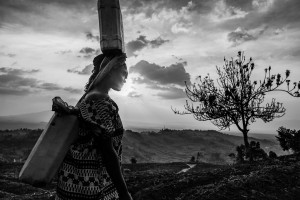By Kimberly Lopez Castellanos
Men are predominantly seen as the “head of the household,” right? So wouldn’t a lot of the burden of keeping up with the household fall on them? If this is true, why is it that women are more vulnerable throughout the world? At this moment, women are suffering from inequality because they are the ones that provide stability and security not only for themselves but for their families as well. Don’t believe me? Let’s look at some examples that show this in relation to climate change. How are women being affected? What can be done to shift this inequality?

Women in developing, mostly rural areas, are often responsible for their family’s food, health, water, and firewood. The effects of climate change, including drought, uncertain rainfall and deforestation, make it harder to secure these vital assets. Women are being denied political participation, jobs, civil rights, land, and opportunities to migrate to a safer place in case of emergencies. Even in the United States, the gender pay gap results in an employed woman earning about 20% less than a man. With that gender imbalance, how are women supposed to look out for their families?
After doing some research, I discovered that the Democratic Republic of Congo (DRC) is considered to be one of the countries most vulnerable to climate change, yet it is one of the countries least prepared for the impacts and with the least amount of resources. An unfortunate issue that is affecting DRC women is malaria. In all of Africa, 50 million pregnant women encounter this disease. From these 50 million, about 10 thousand women and 200 thousand of their infants die as a result of malaria infection during pregnancy. (1)
These women are also struggling to keep their main source of food alive–the cassava. The cassava is a drought-resistant crop that is recently being used more as an adaptation to the current dry lands. To prove its importance, each Congolese consumes an average of 453 kilograms of fresh cassava per year, the equivalent of 145 kilograms of cassava flour. A household of 7 to 8 people consumes about 4 kilograms of cassava per week. (2) This crop has been depleted immensely due to anthropogenic climate change over the past several years. The surface cultivated for a staple crop like cassava has declined from 2.4 million hectares in 1991 to 1.9 million in 2001. An estimated 75 percent of the Congolese population is underfed. (3)
After attending some workshops this week, I encountered a dialogue on women in Kenya in the dry lands. Similarly to the unfortunate circumstances in DRC, women in the dry lands are beginning to travel farther distances for their necessities. The farther they walk, the less time there is for literacy. The less time there is for literacy, the less time they have to learn about their rights. This is crucial because they have to know their rights in order to fight for what they need, including land rights that are essential to survive.
The UNFCCC has mentioned gender equality and women in the preamble, but it is in brackets (of course!). In order to reinforce the importance of mentioning women and gender equality there needs to be PUBLIC funds that empower women to fight for their rights. The dialogue involving women in dry lands emphasized that Adaptation cost estimates vary widely. According to the UNFCCC, global annual financial and investment flows needed for adaptation will range from $49 to $172 billion across five sectors: agriculture, forestry and fisheries; water supply; human health; coastal zones; and infrastructure. (4) The World Bank estimates that adapting to a world that is approximately 2 degree Celsius warmer will cost developing countries between $75 and $100 billion per year between 2010 and 2050. Yet only about $4.4 billion per year is presently being directed (4)
Adaptation efforts needs to focus on funding the differentiation between the needs of men and women. In terms of mitigation, the UNFCCC must recognize and support women’s traditional management techniques because women are big depositories of knowledge that need finance to flourish. There needs to be an ambition to establish some support for equity and empowerment in women within their local communities. There needs to be an establishment of programs that fund these elements.
This income of money needs to come from countries with national capabilities and historical responsibilities, meaning those from the Global North. They are the ones that must make up for the impacts that their industrial eras have caused. The unfortunate developing countries have not had, and may not have a chance to develop. That is why common but differentiated responsibilities and equity are needed in the text. There must be a demand for technology transfer and capacity building to help cases like the women in DRC. 1.5 is now only a number. The global North has coopted the climate justice language, but they must realize that now, in our 0.86 stage, countries are suffering way too much. Their Intended Nationally Determined Contributions have added up to a target 3 or 4 degrees Celsius above pre-industrial warming, IF they decide to achieve their pledges. The text that was released yesterday shows there is a mention of gender equality, but it is still in brackets. Hopefully, this weekend we will be able to see it without brackets, in the text, with a fair target to help women escape this inequality in some way.
Update: A response from Women and Gender Constituency response to the draft version of the text has been released.
- Irene Dankelman, Gender and Climate Change: An Introduction, Earthscan (Sterling, 2010).
- SNV, ‘Improving cassava production and supply systems in DR Congo’, (2012), http://www.snvworld.org/en/regions/africa/publications/improving-cassava-production-and-supply-systems-in-dr-congo (accessed 10 December 2015).
- Food and Agriculture Organization of the United Nations, ‘Research on Congo’s basic crops’, (2011), http://www.fao.org/news/story/en/item/49320/icode/ (accessed 10 December 2015).
- United Nations Development Programme, ‘Ensuring Gender Equity in Climate Change Financing’,http://www.undp.org/content/dam/undp/library/gender/Gender%20and%20Environment/EngendCC_7.pdf (accessed 10 December 2015).
